


Forests cover more than a half of Estonia's mainland territory. There has been constant and rapid increase in forest area and growing stock of stands during the last 60 years. Forests and forestry are of great importance for the Estonian economy and environment.
The production of forest industry accounted for 25% of the total production of manufacturing in 2002, 14% of the total production was produced by the wood processing, 3% by the pulp and paper processing and 8% by the furniture industry.
In 2002 export of wood and articles of wood forms 15% from the total value of the Estonian export. About 30 500 persons work in the forest sector companies.
Estonian Forest Policy and Estonian Forestry Development Plan provide a framework for integrated and increased efforts in forestry, including the development and strengthening of institutions and formulation of the programs for the management, conservation and sustainable development of forests and forest land.
The valid national Forest Act was approved by the Parliament in December 1998 and amended in February 2004. It aims at the promotion of an economically, ecologically and socially sustainable forest management in Estonia.
Forests cover 50,5% or 2,21 million ha of Estonia's mainland territory. As the density of population of Estonia is rather low (31,2 inhabitants per km2), there is 1,63 hectares of forest land and 342 m3 of growing stock per capita. Forest area available for wood supply is 2,07 million ha (about 94% of total forest land area). About 0,14 mill. ha of forest land has been classified as forest not available for wood supply due to conservation reasons and other wooded land (0,08 mil. ha) for economic reason.
There has been constant and rapid increase in forest area and growing stock of stands during the last 60 years - area increased by 2,6 times (from 0,9 mill. ha in 1940 to 2,2 mill. ha in 2002) and the growing stock by 4,1 times (from 108 mil. m3 to 444 mil. m3 respectively). Forest area has increased as a result of the afforestation of unused agricultural lands and the drainage of bogs between 1960-1980s. Due to modest felling volumes in the period 1975-1995 the growing stock have increased from year to year as well. The average growing stock of stands has been increasing since the 1950s by forest melioration (increasing productivity of forest lands), afforestation of non-used agricultural lands and changes in the age structure of stands (the average age of stands has increased).
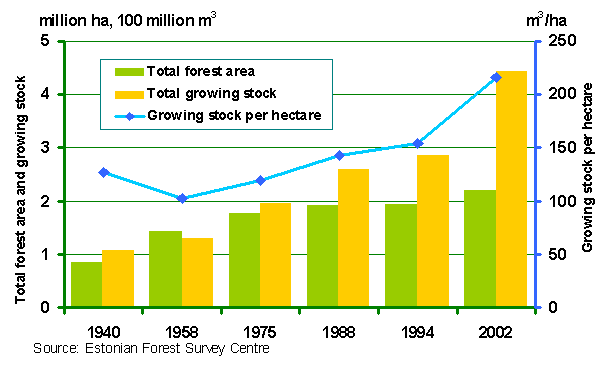
Changes in total forest area, total growing stock and growing stock per hectare of stands in 1940-2002
After the regaining of independence in 1991 the restitution and privatisation process started. By the end of 2002, 3,1 mil. ha of land (of which 1,6 mil. ha of forest land) has been registered in the Land Cadastre and 1,2 mill. ha of land (0,6 million ha of forest land) will be registered in the next 3-4 years to complete the land reform. State-owned forests are managed by the State Forest Management Center (830 000 ha) and by other state institutions (20 000 ha). 795 600 ha of private forests are mostly owned and managed by individuals (80%), but forest companies are increasing their share. Private forest ownership is characterised by the big number of owners (about 70 000) and the dominance of small forest holdings. The average area of forest land in a private property is 10 ha and about 80% of the private holdings have forest land less than 20 ha. Municipalities are playing a minor role as forest owners in Estonia.
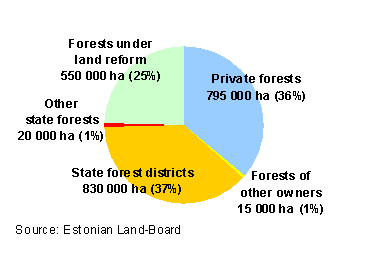
Forest land ownership structure (as of 1. January 2003)
After a deep recession at the beginning of the transition to the market economy the forest sector companies have experienced a rapid and steady increase in 1990s. The development of the forest sector has stabilised in the recent years - share from the GDP has remained at 6-7% level. Especially quick developments took place in the wood processing industry reflecting investments into sawmilling and further processing in the last 5-7 years (share from the GDP has grown from the 1,0% in 1993 to the 3,0% in 2002 by current prices). Forestry (from 1,3% to 2,1%) and furniture industry (from 1,3% to 2,1% respectively) developments have not been so dynamic. Pulp and paper industry has not regained the position it had in the 1980s (share was only 0,4% from the GDP in 2002).
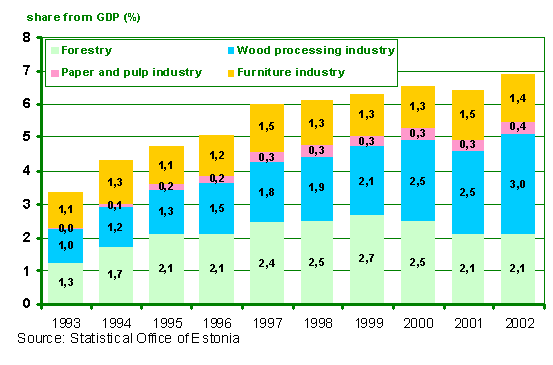
Share of forest sector from gross domestic product (by current prices) in 1993-2002
The production of forest industry accounted for 25% of the total production of manufacturing in 2002 (11% in 1992), 14% of the total production was produced by the wood processing, 3% by the pulp and paper processing and 8% by the furniture industry. The rapid increase of the production of sawn wood has been the main driving engine of the wood processing industry - 0,3 mill. m3 of sawn wood was produced in 1992 and 1,8 mil. m3 in 2002. Forest industry companies produced 38 500 m3 of plywood, 17,9 mill. m2 of fibreboard, 0,19 mill m3 of particleboard, 96 800 m3 of glue-laminated wood, 62 300 MT of pulp, 62100 MT of paper, prefabricated wooden buildings in the value 836 mil. EEK and about 2 mil. pieces of wooden furniture in 2002.
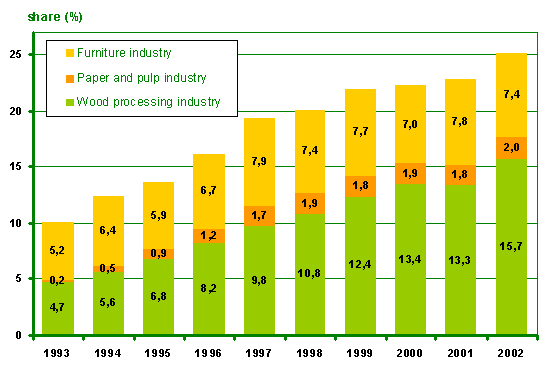
Share of forest industry from added value of manufacturing industry (by current prices) in 1993-2002
The forest industry enterprises invested about 1,5 billion EEK in 2001 that is 33% from the total investments in the manufacturing. About 70% of the forest industry production is exported. Wood and the articles of wood are among the main export articles and the biggest balancers of the overall negative trade balance.
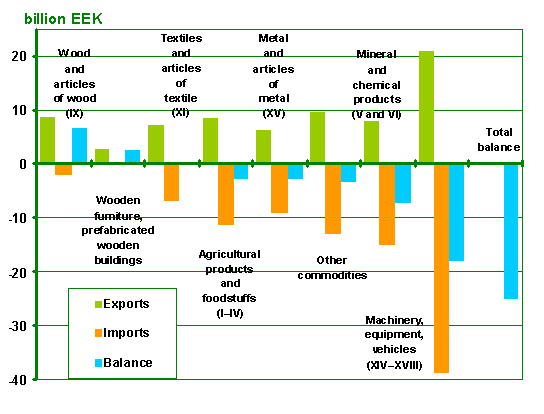
Foreign trade balance by commodity chapters in 2002
Export of wood and articles of wood was 8,6 billion EEK (15% from the total value of the exports) in 2002, respective figure for the pulp and paper products was 1,3 billion EEK (2,3%) and for furniture 2,1 billion EEK (3,6%). Sawn wood, industrial round wood (mostly pulpwood), wooden furniture, prefabricated wooden buildings and joinery and carpentry products were the main wooden export articles in 2002. Articles of wood were mainly exported to Finland, Sweden, United Kingdom, Germany, Denmark, Netherlands and Norway. Value of the imports of the articles of wood was 1,9 billion EEK (2,4% from the total value of the imports), of the pulp and paper products 2,2 billion EEK (2,7%) and of the wooden furniture 0,3 billion EEK (0,4%) in 2002.
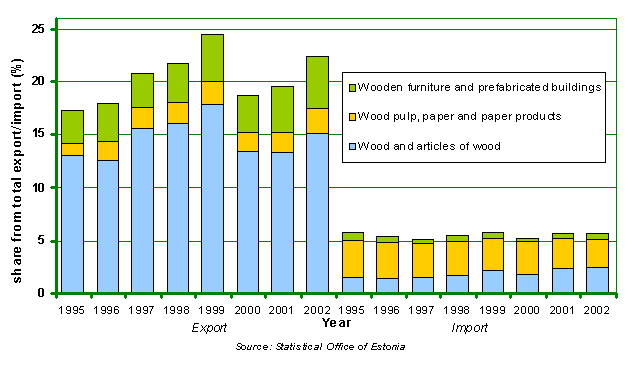
Share of wood and articles of wood, paper and articles of paper, wooden buildings and furniture from total export/import in 1993-2002
30 500 persons worked in the forest sector companies (5,1% from the total number of employed persons, without furniture industry employment figure). The number of persons worked in forestry has remained stable during the last decade - about 9000 persons i.e. 1,4% from total employment - the decrease of the state forestry administration and rapidly increased use of heavy machinery in fellings have been balanced by the intensified use of resources. There have been no big developments in the employment in the pulp and paper industry - about 2000 persons employed (0,3% from total employment). The biggest increase have took place in wood processing industry - employment has doubled during the last decade from 7700 persons (1,1%) in 1993 to 19 800 persons (3,4%) in 2002. About 10 000 persons (1,7%) is employed by the furniture industry (incl. non-wood furniture companies). Besides the direct employment in forest sector, the income of persons in other sectors has been connected to the forests, forestry or forest industry - transport, energy, tourism etc.
 Total number of employed persons in forest sector in 1993-2002 (1000 persons)
Total number of employed persons in forest sector in 1993-2002 (1000 persons)
Most of Estonian forests (about 97%) are semi-natural forests i.e. have been influenced by the management activities. The share of natural and recovering forests is about 2,5% (55 000 ha) and the share of intensively managed monoculture plantations is only 0,03% (800 ha). About 0,5 mil. ha (22,6% of the total forest area) of forest land is designated for forest conservation and protection. The protected forests cover about 0,14 mil. ha (6,4% of the total forest area) and the protection forests 0,37 mil. ha (16,3%). The area of forest managed primarily for soil protection is 63 200 ha (2,8% of the total forest area) and for water protection 144 200 ha (6,4 %). About 16000 ha (5455 sites) of woodland key habitats (areas requiring protection in a commercial forest) was registered during the Woodland key habitat inventory. The development of Natura 2000 network will also add some protected areas in the near future. Half of the 16 000 registered species (birds, mammals, invertebrates, vascular plants, cryptogams and fungi) are connected with forests. 504 forest species are estimated to be endangered (6% of all the forest species), of these, more than 200 species are rare or threatened in Europe and are listed in different "red lists". Some of the European red-listed species are not considered as threatened in Estonia e.g. the large carnivores (the lynx, brown bear and wolf) have been managed as game.
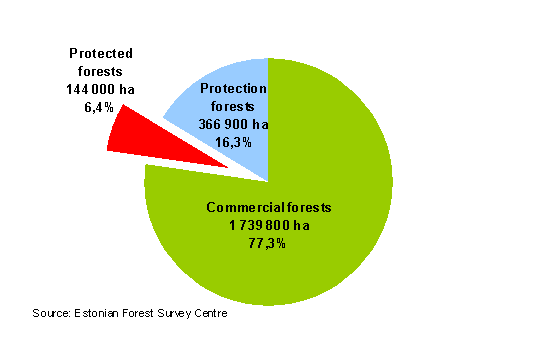
Distribution of forest land by forest categories in 2002 (according to NFI)
The present report gives an overview of progress towards sustainable development in the Estonian forest sector.
In Estonia the leading role in preparation of the environmental and forest policy and legislation has the Estonian Ministry of Environment.
The Ministry of Environment launched Estonian Forestry Development Program with the principal task of formulating the National Forest Policy already in 1995.
The National Forest Policy constitutes the main ideas of forest policy development and implementation in Estonia, thereby such principal issues like strategic target setting and functions of state in forest sector, reorganization of forest administration, establishment an appropriate balance between forest production and conservation and provision of aid and assistance to the private forest owners.
Estonian Forest Policy (EFP) was approved by the Parliament in June 1997. The long-term objectives of forest management are fixed in the document.
According to the EFP, the following two principal and closely linked objectives for the Estonian forestry sector are:
According to the EFP in order to ensure the stable state of the environment, multiple and diverse use of forest, the area of state owned forest shall be at least 20 per cent of the area of the mainland of the Republic of Estonia.
After the approval of the Estonian Forest Policy in 1998-1999 the reorganisation of public forest administration was carried through.
Clear distinction was made between the administrative and commercial functions of the administration, and, as a result two separate institutions were established:
The Estonian State Forestry Administration consist of Forest Department (established at 01.01.2000 as the result of reorganized previous Estonian Forestry Board) under the Ministry of Environment, 15 County Environment Services, Environment Inspectorate and Estonian Centre of Forest Protection and Silviculture, responsible for policy implementation, supervision, forest inventory and monitoring and advise to the forest owners.
For the management of state forests, the State Forest Management Centre, a state profit institution is responsible. Balanced development through the enhancement of the economic, social and environmental values of forests has been set as the primary goal of organization.
In order to implement the EFP Ministry of the Environment decided in 1999 to launch the elaboration of Estonian Forestry Development Plan (EFDP) for ten year period. All major actors within forestry - public forest administration, research, environmental NGO-s, industry, private forest owners association, a.o. participated by drafting of the plan
Six problem areas were determined, which have been thoroughly discussed in working groups, preparing EFDP.
- the use of forest lands, which are temporarily in state ownership and not returned and privatized to date;
- the setting of objectives for the activities of the State Forest Management Agency and assessment of results;
- the prevention of the spread of illegal forestry and the violation of forestry law provisions;
- the determination of the share and location of strictly protected forests;
- the calculation of prescribed cut ensuring consistency;
- the development of extension and support system for private forest owners (Forestry and hunting ..., 2001).
First draft of the document was completed in June 2001, second revised version in April 2002 and in June 2002 the government approved document. After the parliamentary approval in 2002 the plan has a legal status and it could be considered as sustainable development strategy for forestry sector.
Plan presents a number of objectives, measures and a process of evaluation, which together are to ensure the sustainable management of Estonian forests in general. The main programs, requiring support from public funding, determined in the document.
The target, set in the Estonian Forestry Development Plan, was to increase the area of forests under strict protection up to 10% of the total forest area. Already now more than 6,4 % of the all forests are strictly protected.
Integration process into the EU forms a stable political and economical background for the long-time progressive development in Estonian forest sector. Important positions for forestry sector developments are also fixed in the Special Accession Programme for Agriculture and Rural Development 2000-2006 (SAPARD), Single Programming Document 2003-2006 (SPD) and Estonian Rural Development Programme 2004-2006 (ERDP), prepared by Ministry of the Agriculture, which provides the list of rural development measures- the measures of the EFDP are harmonized with these 3 documents. Under SPD the private forest owners and their associations can get support for forest managemental activities and under ERDP the support is foreseen for afforestation of agricultural lands. Both of the measures are foreseen to be implemented form the year 2005.
The valid national Forest Act (FA) was approved by the Parliament in December 1998. The FA came into force from the beginning of 1999. It aims at the promotion of an economically, ecologically and socially sustainable forest management.
The FA applies to both private and state forests, provide the legal basis for the State Forestry Administration and the State Forest Management Centre.
In elaboration of the FA the concept, positions and understanding, fixed in the fixed in Strasbourg, Helsinki and Lisbon resolutions of the
Pan-European Process of Forest Protection has been used.
The FA obliges all forest owners to manage their forests in a sustainable way and at the same time to consider the multiple functions of forests.
According to FA forest owners are obliged to notify county environmental services about planned silvicultural measures, felling and forest damages. These forms are base for state monitoring and supervision of planned and carried out forestry measures by county environmental services in private forests.
In 2002-2003 the valid Forest Act was under revision, as a follow-up to the new Estonian Forestry Development Plan. The revision intends to create a more comprehensive legal framework for taking into consideration the various aspects of sustainable forest management, concentrated especially on formulation of new restrictive conditions for illegal forestry related activities in private sector. New version of Forest Act (Forest Act from 1998 with the amendments in 2003) approved by parliament in February 2004.
The national forest inventories data collection and processing system will be based on the State Register of Forest Resources, which is in stage of elaboration and implementation. In end of 2004 data about 95% of state and 50% of private forest area will be covered by register. Collection of information about several indicators of sustainable forest management will be also based on register.
In 1998 work for the establishment of the sample-plot based National Forest Inventory began. The methodology of statistical forest inventory is currently under development. The role of the National Forest Inventory is to provide unbiased, reliable information on forest resources and conditions in large areas. Inventory provides decision-makers with consistent, reliable and up-to-date information about forestry. The information has been used in drafting of the Forestry Development Plan, in formulation of the forest policy, determining the level of cuttings and regeneration and in the strategic planning of forest sector.
The State Forest Management Centre elaborated for the management of state forests own new information system, concentrated on the accounting system and GIS based database of forest resources.
The national working group on forest certification was established in November 1998
The working group started with collecting relevant background information and organizing number of seminars about existing forest certification schemes and international requirements posed on forest certification.
The main task was to draft Estonian Sustainable Forest Management Standard, based on FSC 10 Principle and 56 Criteria (FSC P&C), which was completed and acclaimed like national agreement in December 2000.
In 2001 certification on practical level started and already in 2002 the Estonian state forests (38% of all forests) were granted a FSC and ISO 14001 Forest Management certification.
Forests and forestry are of great importance for the Estonian economy and environment.
Development of the Estonian forestry has been influenced by its geographical position, history, by the general political, social and economic situation.
Estonian forest policy is closely linked with policies of environment, agriculture and rural development, industry, energy and other sectors. Estonian Forest Policy and Estonian Forestry Development Programme until 2010 (EFDP), prepared by the Ministry of Environment, provide a framework for integrated and increased efforts in forestry, including the development and strengthening of institutions and formulation of the programs for the management, conservation and sustainable development of forests and forest land
The basic forestry related legal documents have been, based on policy development, renewed already 3 times during the time of independence. The valid national Forest Act (FA) was approved by the Parliament in December 1998 and amended in February 2004. The amendments concentrated especially on the strengthening of the forest administration, formulation of new frame conditions for forest management planning, needs for the plans and process of their approval, also new restrictive conditions for illegal forestry related activities in private sector.
Local forest resources, quite well developed infrastructure and investment-friendly environment facilitated progress of wood processing industries, characterised by modernisation of technology and equipment, product development and diversification.
Today the main target is to harmonise the intensive use of timber with the environmental and recreational needs in forestry following the principles of the sustainable forest management, fixed in the Estonian Forestry Development Plan for ten year period. According the Forest Act and the Estonian Forestry Development Plan, different production and environmental functions and goals, also social aspects of sustainable forest management have equal priority.
Estonian wood-processing industry is today export oriented, but domestic demand for wood products is slowly increasing. In 2002 export of wood and articles of wood forms 15% from the total value of the Estonian export.
Good know-how and experience in the raw material market of the Russia and other CIS countries and well developed wood processing technology and transport network are factors, able to decrease the load to Estonian forests as timber resource in the near future. Already today, about 35-40 % of the whole volume of wood, processed by the Estonian forest industry, imported. At the same time role of environmental and recreational aspects in forestry increased continuously.
Important factor for progressive development in the sector is property reform. Privatization and restitution became the foremost important items in the transition process.
Although owners of all logging and wood processing enterprises are private companies, property reform of the forest land is still ongoing and quite slowly. Second problem is related to the area of forest holdings, which is too limited and fragmented for effective forest management. Many of forest owners are living beside of the property, the financial capabilities, equipment, competence and professional skills, also interest for effective forest management are sometimes quite limited.
Other problem is connected with formation of new private forest sector companies, overly profit-oriented functions of which could also lead somewhere to neglect of the environmental aspects of forestry.
The network of private forest owners associations is existing and forestry extension system is shaped out, but many farmers are not actively participating, communication with a huge number of small forest owners is still weak and whole system is still in the initial stage of development. Private forest owners associations represent the interests of private forest owners at the national and political levels nevertheless quite actively. Further development of professional forestry extension system with high levels of participation by all partners is however essential for the long term sustainable forest management in Estonia.
Prepared by Kalle Karoles, Mati Valgepea and Indrek Laas.